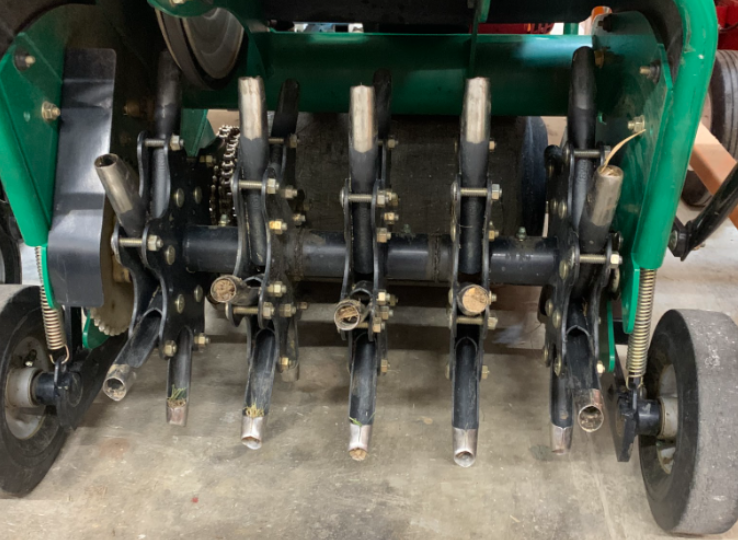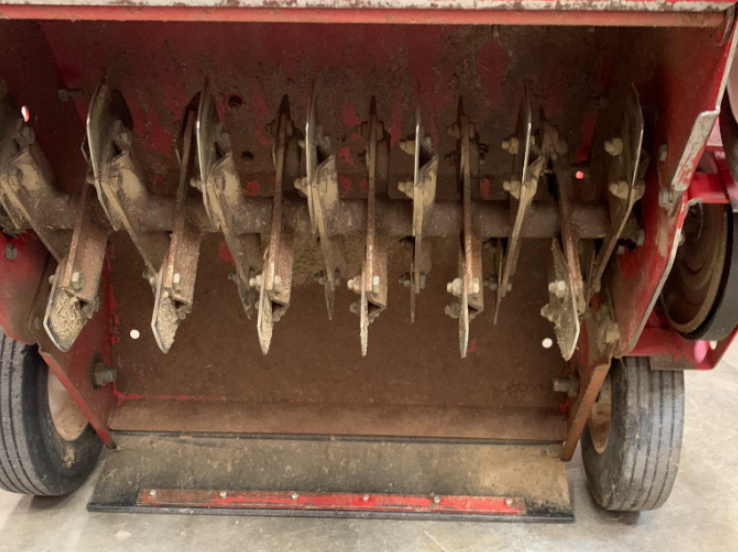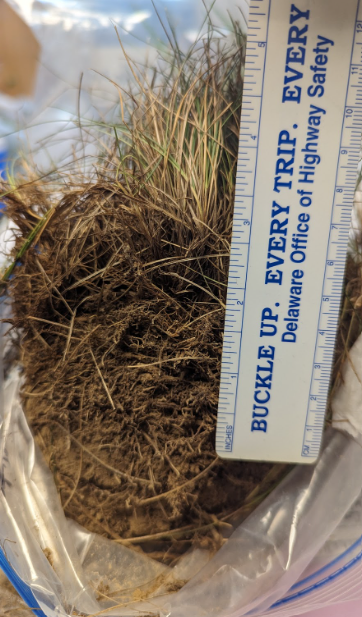
Fact Sheets And Publications
Thatch Management for Turfgrass Systems
November 2025 | John Emerson Jr.
Dr. James Beard’s Turfgrass Encyclopedia defines thatch “as an intermingled organic layer of dead and living shoots, stems, and roots of grasses that develops between the turf canopy of green vegetation and the soil surface”. The thatch layer is one of the most common and persistent challenges in turfgrass management. While a thin layer (<1/2 inch) offers benefits like cushioning, stand structure, and wear tolerance, excessive thatch can create a plethora of problems that can quickly degrade turfgrass quality. Effective thatch management often requires a combination of cultural and mechanical practices. Rhizomatous grasses, such as Kentucky bluegrass, zoysiagrass, and bermudagrass tend to be more prone to excessive thatch and may require a closer inspection of management practices when growing these grasses.
Thatch Production
Thatch accumulates when the rate of organic matter production (grass growth) exceeds the rate of decomposition. As the grass grows, organic material is constantly being deposited. The material is primarily composed of lignin-rich tissues that are resistant to microbial decomposition and break down slowly. Some thatch is beneficial by providing:
Cushioning: provides stand resilience and physical support, improving the turf’s ability to withstand traffic.
Soil insulation: It helps stabilize soil temperatures and reduce water loss via evaporation.
Bio-filter: thatch can sequester and immobilize pesticides and nutrients that may be prone to leaching.
However, when the thatch layer thickens beyond half an inch, it transforms into a hydrophobic carbon-rich barrier that isolates the turf's roots from the soil leading to a decline in turfgrass quality.
Consequences of Excessive Thatch
A thick layer of thatch disrupts the essential relationship between the turf and the soil, creating a favorable habitat for pests and diseases:
Shallow Rooting: Roots tend to grow within the thatch layer rather than penetrating the soil. This makes the grass highly susceptible to drought and heat stress as the roots cannot access deeper pools of soil water.
Poor Water Infiltration: Thatch can create hydrophobicity issues, causing water to pool near the soil surface or run off, even when the underlying soil is dry. Localized dry spots become pronounced.
Fertilizer and Pesticide Tie-Up: The excessive organic matter layer can bind chemical applications and prevent fertilizers and pesticides from reaching the root zone. Turfgrass response to fertilizers and pesticides is often compromised.
Increased Disease and Insect Activity: Thatch provides an excellent environment for pathogens and insects, leading to higher incidence of disease outbreaks and insect infestations such as brown patch and white grubs, respectively.
Cultural Practices for Prevention
The most sustainable and primary approach to thatch control involves slowing its formation by reducing nitrogen (N) fertilizer inputs. Both individual application and yearly N totals need to be reduced. Consider cutting N application rates by 25% (or more), year over year, until a good balance is achieved between thatch production, decomposition, and turfgrass quality. Turfgrass managers are often quite surprised how much N rates can be lowered and still produce good performing turf, especially when thatch has become excessive. Secondary practices will alleviate the symptoms caused by excessive thatch, yet they do not address the root problem of deposition.
Primary
Nitrogen Management: Avoid excess N application, which promotes rapid, succulent growth that contributes quickly to the thatch pool.
Soil pH: An extreme soil pH (<5.5 or >8.0) can inhibit microbial populations and reduce the efficiency of thatch decomposition
Soil Compaction: When soils become compacted the movement of air and water, which is crucial to decomposition, is restricted to the upper portions of the profile.
Secondary (Mechanical)
Core Aeration : Removing small cores of soil (and thatch) allows air, water, and nutrients to penetrate the root zone. The soil cores deposited on the surface introduce soil microbes to the thatch layer, significantly enhancing decomposition. Aeration should be performed once or twice during the peak growing season. More may be required when thatch is excessive. (Fig. 1)
Vertical Mowing (Verticutting): This uses rotating vertical blades to slice into the thatch layer, pulling the material to the surface for collection. The depth of the slice should be set deep enough to penetrate the thatch without excessively damaging the turf. (Fig. 2)
Power Raking: Similar to verticutting, power rakes use spring tines or stiff blades to aggressively pull material from the turf surface.
Doing the basics correctly, like mowing and irrigating, goes a long way to help prevent excessive thatch build-up as well. Maintain sharp mower blades to avoid unnecessary stress or tearing of the leaf blades. Grass clippings, which are an easily decomposable material, do not contribute to thatch and should be mulched back to the turf. Practice deep and infrequent watering to encourage deeper rooting and avoid creating a continually moist thatch layer. Of note, dethatching, verticutting, and heavy aerification will put significant stress on the turf. It should always be followed by irrigation, fertilization, and sometimes overseeding to foster recovery. Perform mechanical practices during periods of natural vigorous growth. Spring and fall for cool-season grasses, summer for warm-season grasses.
Conclusion
Effective thatch management is a continuous process rooted in basic turfgrass management principles. By reducing N and implementing cultural practices like core aeration or verticutting, turfgrass managers can maintain an acceptable thatch layer and produce good performing turf.



UD Cooperative Extension
This institution is an equal opportunity provider.
In accordance with Federal law and U.S. Department of Agriculture policy, Cooperative Extension is prohibited from discriminating on the basis of race, color, national origin, sex, age, or disability.
